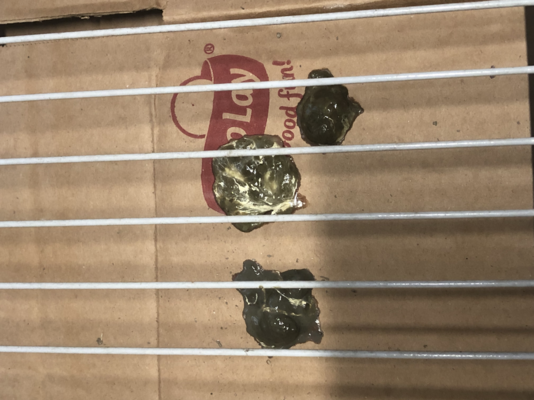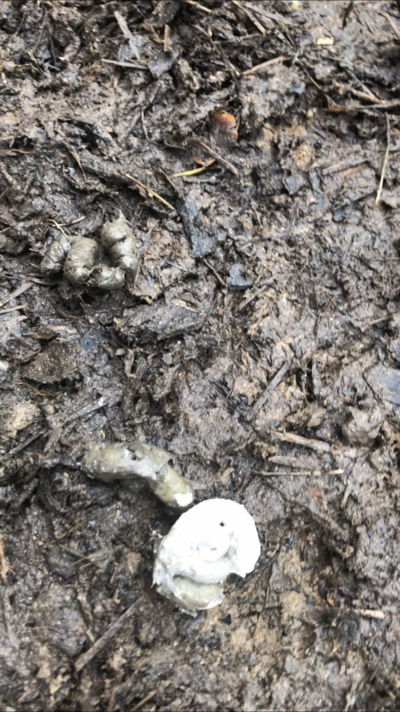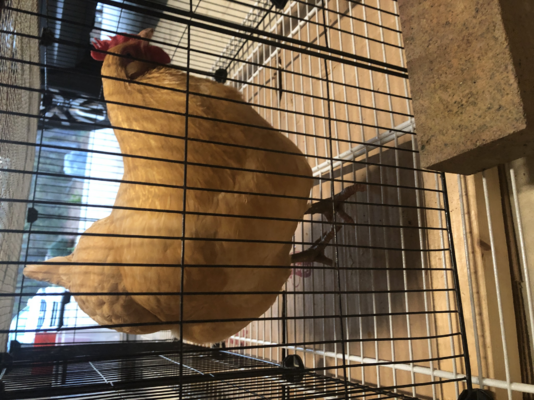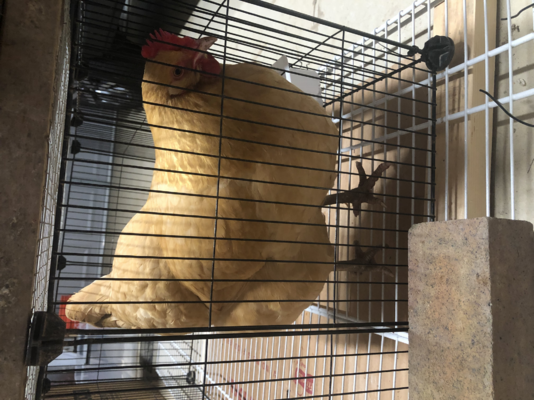applethechicken
Chirping
This is Apricot, she’s 8 months old and lays. Yesterday morning (Wednesday 11/16) I noticed she had a very large crop, but that was after she had ate already. It was about the size of a softball. I didn’t separate her then because she was still very active and eating. I just gave her some coconut oil and tried massaging. (She also was drinking the garlic water that I had for everyone) I think it was around 45 minutes of massaging in total, but the crop didn’t get smaller, neither did it get bigger even though she ate. I did catch a avocado green cecal poop, and a normal poop yesterday afternoon (pic attached, it’s the one on the dirt, sorry for bad lighting). But her poop frequency has gone down, to over an hour instead of 30 minutes.
This morning (11/17), I caught her coming out of the coop at dawn, and it is still the size of a golf ball, or a little bit larger. I’ve now put her in my garage with only garlic water and grit. I also attached a picture of her poops from morning (the ones on the cardboard). It definitely doesn’t look normal. It looks oily, which could be from the coconut oil yesterday. She still wants to eat, and she’s also growling a lot
All the other 4 chickens are fine. I spend time with them everyday, and yesterday was the first day I noticed it was abnormally large. The contents in her crop don’t feel like a liquid, or solid like a rock. It’s squishy and pliable, like bread dough, but doesn’t hold its shape. No nasty smell.
She’s still active and wants to eat. She’s drinking a lot of the garlic water (like every few minutes).
Possible causes I can think of:
1. She eats everything, so many she ate something bad? I don’t have long grasses (large run, not free range), but she does eat vegetables and herbs, and she likes eating grass, but it’s short.
2. It has been raining a lot here, and she always goes to the uncovered parts of the run when there’s light rain, and she’s always digging through the mud.
3. She also has been spending a lot of time laying for the past few times, like it takes her over an hour in the nesting boxes, but never sick egg bound symptoms. The egg shells are still hard though. She gets egg shells and oyster shells, but she prefers the egg shells, and ate A LOT of them a few days ago, to the point where I could see small pieces in her poop. So maybe there’s too many egg shells stuck in there?
Also, she has always sneezed more than the others (once every hour or so), ever since she was a baby chick. It’s never wheezing or any discharge.
Lastly, I haven’t dewormed anyone yet, since they’re only 8 months old. They do get garlic water once a month for a week though.
Is this doughy crop? How do I treat? Should I massage? I’ve read just about every article and thread on sour/ doughy/ impacted crop on here, but I’m not sure which one she has.
Please help. I feel like I’m always dealing with chicken problems and sicknesses, and now my healthiest one is having problems too.
This morning (11/17), I caught her coming out of the coop at dawn, and it is still the size of a golf ball, or a little bit larger. I’ve now put her in my garage with only garlic water and grit. I also attached a picture of her poops from morning (the ones on the cardboard). It definitely doesn’t look normal. It looks oily, which could be from the coconut oil yesterday. She still wants to eat, and she’s also growling a lot
All the other 4 chickens are fine. I spend time with them everyday, and yesterday was the first day I noticed it was abnormally large. The contents in her crop don’t feel like a liquid, or solid like a rock. It’s squishy and pliable, like bread dough, but doesn’t hold its shape. No nasty smell.
She’s still active and wants to eat. She’s drinking a lot of the garlic water (like every few minutes).
Possible causes I can think of:
1. She eats everything, so many she ate something bad? I don’t have long grasses (large run, not free range), but she does eat vegetables and herbs, and she likes eating grass, but it’s short.
2. It has been raining a lot here, and she always goes to the uncovered parts of the run when there’s light rain, and she’s always digging through the mud.
3. She also has been spending a lot of time laying for the past few times, like it takes her over an hour in the nesting boxes, but never sick egg bound symptoms. The egg shells are still hard though. She gets egg shells and oyster shells, but she prefers the egg shells, and ate A LOT of them a few days ago, to the point where I could see small pieces in her poop. So maybe there’s too many egg shells stuck in there?
Also, she has always sneezed more than the others (once every hour or so), ever since she was a baby chick. It’s never wheezing or any discharge.
Lastly, I haven’t dewormed anyone yet, since they’re only 8 months old. They do get garlic water once a month for a week though.
Is this doughy crop? How do I treat? Should I massage? I’ve read just about every article and thread on sour/ doughy/ impacted crop on here, but I’m not sure which one she has.
Please help. I feel like I’m always dealing with chicken problems and sicknesses, and now my healthiest one is having problems too.
Attachments
Last edited:







